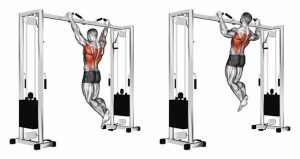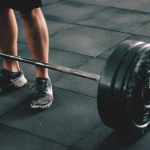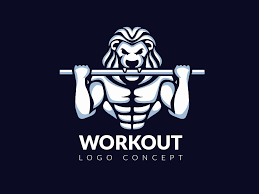
Are there any exercises in Crossfit, fitness, and bodybuilding that allow you to progress for a very long time without requiring additional weights? Yes – this is basic exercises on the back. At the same time, the best of them are considered to be pull-ups a wide grip. Let’s consider in more detail.
Content of the article:
- What is worth knowing before training?
- Potential harm and contraindications
- Benefits from workouts
- What muscles work?
- Technique of execution
- With what to combine?
- The result
- How to: wide grip pull up

What is worth knowing before training?
Yes, of course, pulling up a wide grip is not a panacea for all problems. But at the same time it is:
- Basic multiarticular exercise, which involves almost all the muscles that are above the calf level;
- perfectly develops the muscles of the bark;
- suitable for athletes beginners;
- has minimal traumatic danger.
Potential harm and contraindications
But are pullups so good with a wide grip? Despite their effectiveness, they have a number of very specific contraindications, and in some cases can even harm the body of a beginner athlete. In what cases is it strictly forbidden to use pull-ups with a wide grip in the main training program:
- Diseases in the elbow joint. Even with special insuring bandages, it is highly recommended not to engage with elbow joint problems in a wide grip. With a wide grip, the elbows work in an inconsistent natural amplitude, which increases their horizontal load, and, accordingly, can lead to rapid abrasion of the joint.
- Diseases of the spine. When pulling, the weakened spine is stretched, which is an undeniable benefit. But in the presence of kyphosis or scoliosis, this stretching can lead to probable jamming of nerves.
- Problems with the abdominal region. This refers to the post-traumatic period, or the time after surgery, when the muscles of the press have not yet acquired sufficient tonus, and can not hold the spine and the body in the correct state.
- For the same reasons as the previous one. During pull-ups with a wide grip, the muscles of the cortex and the press are in extreme stress, which can damage the fetus even in the first weeks of pregnancy.
- Excess weight. It is not a contraindication, but a warning. Many athletes prefer the jerky pace of the exercise, which is completely uncomfortable with pull-ups, and therefore can lead to both pinching and abrasion of the vertebrae, which is highly undesirable for a beginner athlete struggling with excess weight.
In the rest, pulling up on the crossbar with a wide grip does not have more clembuterol gym specific contra-indications. All that is described earlier, is applicable to almost any exercise in the gym.
As for the potential harm, there are no special problems here. The only thing, in violation of technology, pull-ups can lead to:
- Pinching of the cervical nerve. It concerns only the variation of the exercise with the capture and lifting of the body by the head.
- Abrasion of the vertebrae. This is possible only when working with large weights, and incorrect departure from the working shell.
- Strengthening the curvature of the spine. This can occur only in the case of the unevenly developed muscular corset of the back, and the presence of kyphoschnosyliasis curvatures of the spine at least of the second degree.
As can be seen from the listed pull-up on the bar wide grip almost do not harm the healthy body, while observing the correct technique of performing the exercise.
Benefits from workouts
Can this exercise help build a powerful muscle corset back? And why do a sip with a wide grip on the head or chest? Does the benefit, potential harm from performing such a complex multi-articular complex outweigh the benefits?
So, pull-ups:
- Develop a muscle corset back – this allows you to avoid a lot of injuries in the home and in the gym.
- They have the simplest technique of execution.
- The natural movement of muscles in the working amplitude. This secures the real possibility of the muscles to pull their own body.
- Develop the muscles of the press. With the right load, pull-ups involve even oblique abdominal muscles, which makes them the most useful exercise among all those involved in the abdominal area.
- This exercise stimulates the synthesis of testosterone, since it is the most stressful, and therefore uses all the resources of the body.
What muscles work?
Using pull-ups with a wide grip allows you to progress very long without changing the load, but what muscles work during the approach?
| Muscular group | Load Phase | Load type |
| The widest back muscles | Raising the body to the crossbar | Basic dynamic |
| The rhomboid muscles of the back | Raising the body to the crossbar | Basic dynamic |
| Trapezius muscle of the back | Raising the body to the crossbar | Basic dynamic |
| Lumbar section | Raising the body to the crossbar | Basic dynamic |
| Muscle flexor arm | Raising the body to the crossbar | Basic dynamic |
| Muscles Extensor | All the time | Stabilizing passive |
| Abdominal muscles | All the time | Stabilizing passive |
| Neck muscles | All the time | Stabilizing passive |
| Muscle flexors of the legs | All the time | Stabilizing passive |
| Thoracic muscles | All the time | Stabilizing passive |
| Musculoskeletal | All the time | Stabilizing passive |
| Wrists | All the time | Stabilizing passive |
As can be seen from the table – the main load falls on the dorsal muscle girdle. In this case, the muscles of the press take part in stabilizing the body, and wrists act as the main static-dynamic load. Such a broad involvement of all muscle groups requires the preparation of each of them separately. And most importantly – allows you to work the entire body, and even in the absence of other exercises, maintain muscle tone at the proper level.

Technique of execution
How correctly to carry out this exercise? Despite the seeming simplicity, there are several nuances that should be followed, both to increase the overall effectiveness of the approach, and to reduce the traumatic danger that was previously reported. The classical technique of implementation implies the following procedure:
- Approach a suitable height. The height is determined in such a way that being on the crossbar, you can with the tips of the socks, lightly touch the floor. This is necessary in order to smoothly descend from the projectile during operation in the reject mode and minimize the twisting load on the spine, thus maximizing stretching.
- Set the palms to the desired width from each other. Determination of width – two palms on each side of the width of the shoulders.
- Grabs the projectile, slightly bending his legs under him, to level the use of leg muscles when pulling.
- Slowly tighten, keeping the deflection in the back.
- Then stay at the top for 1-2 seconds.
- After this, start the descent from the projectile as slowly as possible.
- The bottom point should not be in full elbows. It is enough to save a 10-15 degree bend. This will reduce the load on the joints, will avoid the 30-degree bond barrier, and most importantly, will retain some of the static load on the target muscle groups.
- Rise again to the crossbar.
The pace of exercise is very moderate. For explosive pull-ups, it is better to use other variations of grip. When working with weight, you need to pay special attention to breathing. Inhalation on the descent, exhalation on the rise.
And most importantly – when working with weighting (regardless of whether the chain is this or the weighting belt), you need to pay special attention to the deflection in the shell, and additionally monitor the position of the neck. During the descent from the projectile, in no case can not jump. You need to go down (until the full extension in the elbow joint), then align the position of the legs. And touching lightly with the tips of the toes of the floor, slowly unclench your fingers. This is necessary in order to minimize the consequences.
In particular, during pull-ups, the spine is slightly stretched. A jumping sharply compresses, stretched muscles and vertebrae, which can lead to pinching in the case of a strong pre-stretching.
With what to combine?
Since this is a complex, multi-joint exercise, the answer to the question – what can replace the pull-ups with a wide grip – can be so: only a set of three exercises:
- Deadlift thrust with heavyweight;
- Thrust rod rod in slope;
- The barbells behind the back.
At the same time, it is clear that if you want to simulate a wide setting of hands in this exercise, then you will have to fret over the appropriate setting of hands in the exercises. No raznochvatov in the dead and draft in the slope, as the load should be distributed evenly across all muscle groups, regardless of the degree of development of the spinal muscular corset. As for whether it is worth replacing the pull-ups with a wide grip, or is it better to supplement this exercise with single-joint insulating ones? Naturally, it is better to use natural movement, and combine it with isolates, to achieve faster progress. In the standard program, it might look like this:
- pulling up a wide grip to the chest;
- Traction of the T-neck for development of the middle side of the back;
- dumbbells along the body;
- lifting the bar to the bicep.
Basic precautions make pulling in the gravitron a wide grip. Further, to work out the middle of the back (which is not involved because of the peculiarities of the movement), the traction of the t-griffon in the slope is used. After this, the shags – finish off the trapeze to the general state of congestion, and lifting the bar to the biceps loads almost non-participating extensors. Together, this gives an ideal load.
Or another variant of combining pull-ups with other exercises:
- pulling a wide grip on the head;
- pull of the vertical block with a back grip;
- traction of the horizontal block with a straight grip;
- traction of the crossover to the chest;
- lifting the rod in the Scottish bench;
- gravity;
- hyperextension with high weight;
Here the main emphasis is on the fact that the muscles of the back have already received preliminary pre-tampon, and therefore will be able to develop the greatest strength during this period in other exercises. In fact, each following exercise, finishes the main muscle group, while shifting the isolating emphasis on other muscle groups.
The result
Pulling up a wide grip, this is a unique exercise that has come into the sport since the days of ancient Greece. Thanks to the correct setting of hands, adolescents can expand their back and chest, receiving magnificent broad shoulders (due to physical changes in the skeleton).

In adolescence, due to pull-ups, you can even slightly increase your age (by 1-2 additional centimeters per year of continuous studies). For adult athletes, this is an excellent basic exercise, which in combination with:
- bench exercises;
- exercises on the lower part of the legs;
- deadlift.
Allow to develop all the basic muscle groups, becoming stronger, more powerful, and more relish. But the most important thing is not to forget about the additional isolation load, and the increase in weights, approaches, repetitions. After all, without this, progress in pull-ups is simply impossible a priori, as in other exercises. Remember! If you have a choice between stanovaya and pull-ups, always choose pull-ups. They develop almost the same muscle fibers, and most importantly reduce the possibility of injury in dozens of times!






